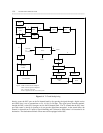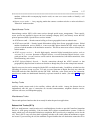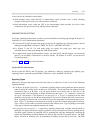1-38 TRUNKING
_ ___________________________________________________________________________________________________________________________
_ ___________________________________________________________________________________________________________________________
_ ___________________________________________________________________________________________________________________________
the switch of origin for routing and processing, and, then, disengages the RLT, readying it for another call.
Advanced Private Line Termination (APLT) Trunks
APLT trunks handle calls between private switches on customer premises and private switches on central
office premises. Services like Common Control Switching Arrangements (CCSA), Enhanced Private
Switched Communications Service (EPSCS), and AUTOVON (on the System 85 and Generic 2) are
provided via APLT trunks.
Remote Access Trunks
These trunks connect a PBX to a central office to provide off-premises PBX users with access to outgoing
PBX trunks. Remote access trunks offer this service by providing off-premises users with PBX dial tone
through the central office.
Host-Access Trunks
Although a switch’s line ports can access a host computer’s ports, two types of trunks can also provide host
access:
• DMI trunks — Connect remote or local hosts to System 75, System 85, or Generic 1 or 2
communications systems. Signaling over these trunks is either, message-oriented (MOS) (for Generic 1
or 2 only) or bit-oriented (BOS). For more details, see the feature description manual for Generic 1
(555-200-201) and Generic 2 (555-104-301).
• Pseudo-trunks — DCP (TN754/SN270) or EIA (TN726/SN238) line ports on the System 85 and
Generic 2 communications systems that have been administered as trunks. On the switch, these lines
are translated as trunk types 103 – 107. Trunk groups of this type are limited to a maximum of 99
ports. The number of trunk groups allowed varies with the release: the maximum number of trunk
groups on the System 85 R2V3 and earlier is 255; the System 85 R2V4 and the Generic 2 permit up to
999 trunk groups. See the Generic 2 feature description manual, 555-104-301 (under Host Access), for
more details.
CONNECTIVITY
From the originating switch, access to the destination switch may be through various telephone company
switching arrangements.
Access can be arranged through the local exchange company (LEC) or the interexchange carrier.
• The LEC may arrange access to applications that it provides (like DID, WATS, and so forth). In
addition, through the LEC, you may arrange access to some of the interexchange carrier applications,
like Software-Defined Network (SDN).
• Through the interexchange carrier, you may arrange special access to the applications that they provide
(like MEGACOM and ACCUNET).
• Either the LEC or the interexchange carrier can lease you private lines to connect the switches in your
private network.


















